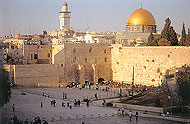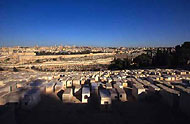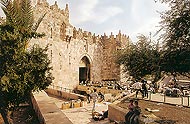Ziemia Zbawiciela |
|
Jubileusz Chrześcijaństwa
|
|
| strona główna opracowania | strona uzupełniająca o wystawie | |
| Działy wystawy: 1. Geografia, położenie, klimat, przyroda 2. Archeologia biblijna, historia 3. Opisy Ziemi Świętej, przewodniki 4. Jerozolima, Święte Miasto 5. Pielgrzymki, podróże (relacje, opisy) |
 |
4. Jerozolima |
| Oddzielne miejsce (5 gablot) miała tutaj Jerozolima. Najstarszą publikacją w tej części było rosyjskie, z 1824 roku, Opisanie iudejskoj zemli vo vremja Isusa Christa. S' gravirovannoj i raskrasennoj kartoj. Z przewodników w języku polskim najstarszym był tom Ziemia Święta o. Norberta Golichowskiego (Lwów 1896 r.) Były też pojedyncze zeszyty polskiej, francuskiej, włoskiej, hiszpańskiej, niemieckiej i angielskiej wersji czasopisma Ziemia Święta, wydawanego przez franciszkanów z Kustodii Ziemi Świętej w Jerozolimie. |
| 1. Jerusalem. [B. m. r. XIX w] 8° podł. tabl. 30. 2. Michaud Joseph: Obrazy Jeruzalem i świętych okolic. Wyjątek z listów o Wschodzie. Przeł. Ludwik Adam Jucewicz. Wilno 1840 Druk. B. Neumana 16° ss. 158. 3. Poujoulat Jean Joseph Fran(ois: Histoire de Jérusalem. Tableau religieux et philosophique comprenant l'entrée des Hébreux dans le pays de Chanaan, leurs destinées monarchiques... [T.] 1, 3. Bruxelles 1842 Meline, Cans 16° ss. 296 + 282, mapa 1. 4. Muravev Andrej Nikolaevič: Istorija svjatago grada Jerusalima. Ot' vremen' apostol'skich i do našich'. Č. 1. S.-Peterburg 1844 V Tip. III. Otdel. Soostv. E. I. V. Kanceljarii 8° ss. XIV, 389. 5. Josephus Flavius: Oblężenie i zburzenie Jerozolimy. Lwów 1856 Druk. Kornela Pillera 8° ss. 80. Biblioteka Lwowska. Seria I. Zesz. 2. |
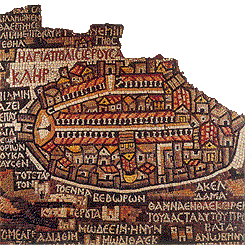 |
Najstarsza mapa świata biblijnego, ok. r. 565 [ 1 ] [ 2 ] Odkryta w jordańskiej Madabie (w kościele z VI wieku) mozaika przedstawia okoloną murami Jerozolimę - w centrum świata bizantyńskiego. Po podziale cesarstwa rzymskiego w 395 roku spadkobiercami Ziemi Świętej zostali władcy Bizancjum, którzy wznosili w całym regionie kościoły dla uczczenia ważnych miejsc, mających znaczenie w życiu Chrystusa. Kiedy tereny te podbili muzułmanie, takie kościoły bywały przekształcane w meczety. |
Ilustracja - archiwum Studium Biblicum Franciscanum, Jerozolima; za: National Geographic Polska, nr 10 (37), październik 2002 |
|
| 6. Environs of Jerusalem. London 1857 T. Nelson 16° ss. 48, nuty. 7. Wolff Philipp: Jerusalem. Nach eigener Anschauung und den neuesten Forschungen. Leipzig 1857 J. J. Weber 16° ss. XIV, 231, [1], plan 1. 8. De Saulcy Felicien Caignart de: Les derniers jours de Jerusalem. Paris 1866 Hachette 8° ss. [6], 437, tabl. [9], 2 mapy, il. 9. Lämmer Hugo: Coelestis urbs Jerusalem. Aphorismen nebst einer Beilage. Freiburg i. Br. 1866 Herder 4° ss. 148. 10. Wartensleben Alexander: Jerusalem Gegenwärtiges und Vergangenes. Berlin 1868 Barthol 16° ss. VIII, 198, tabl. 1, mapa 1. 11. Lubomirski Józef: Jérusalem. Un incrédule en Terre Sainte. Paris 1882 Calmann Lévy 16° ss. 332. 12. Mommert Karl: Die Heilige Grabeskirche zu Jerusalem in ihrem ursprünglichen Zustande. Leipzig 1898 E. Haberland 8° ss. 256, 1 plan. 13. Jerusalem. Rundblick von Turme der Erlöserkirche. Leipzig [po 1898] B. Hentschel 2° tabl. 1 złoż. z 11 części. 14. Besant Walter, Palmer Edward Henry: Jerusalem the city of Herod and Saladin. 4. ed. London 1899 Chatto and Windus 8° ss. XIV, [1], 532, tabl. 7, mapa 1. 15. Mommert Karl: Golgotha und das hl. Grab zu Jerusalem. Leipzig 1900 E. Haberland 8° ss. 280, rys. |
| Poniżej - 'Zburzenie Jerozolimy', obok - 'Świątynia Salomona' |
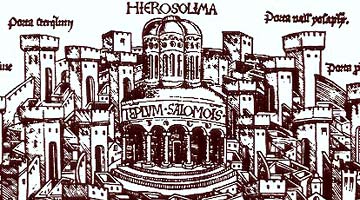 |
|
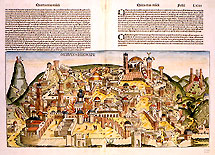 |
||
|
|
||
| 16. Mommert Karl: Topographie des alten Jerusalem. Tl. 2. Das Salomonische Tempel und Palastquartier auf Moriah. Leipzig [1903] E. Haberland 8° ss. VII, 305, [1]. 17. Lagerlöf Selma: Jérusalem en Terre Sainte. Texte français d' André Bellessort. Paris 1905 Ed. Nilsson 8° ss. 295, [2]. 18. Kondakov Nikodim Pavlovič: Jerusalim christianskij. Istoričeskij očerk i pamjatniki. S.-Peterburg 1905 Tip. V. Ja. Mil'štejn 8° ss. [2], szp. 88, tabl. 16. 19. Lagerlöf Selma: Jerusalem II. Im Heiligen Lande. Einzige berechtigte Übersetzung aus dem Schwedischen von Pauline Klaiber. München 1909 Albert Langen 16° ss. 385, [1]. 20. Hanauer J. E.: Walks about Jerusalem. London 1910 Soc. F. Promot. Christ. Amongst the Jews 8° ss. XV, [2], 260. 21. Jerusalem. Die Heilige Stadt und Umgebung. Rundschau vom Turm der Dormitio. München-Gladbach 1910 B. Kühlen 8° harmonijka [8] s. tabl. 22. Lesetre Henri: Le temple de Jérusalem. 3e éd. Paris 1912 G. Beauchesne 16° ss. VIII, 216, il. 23. Vogu Eugene Melchior de: Jérusalem, hier et aujourd'hui. Notes de voyage. Paris 1912 Plon 8° ss. 109. 24. Höpfl Hildebrand: Die Stationen des heiligen Kreuzweges in Jerusalem. Freiburg i. Br. 1914 Herder 16° ss. 119, tabl. 1. 25. Slisansky Laurentius: Neue Reisebeschreibung nacher Jerusalem undt dem H. Landte. Beschrieben... anno 1662. Leipzig [1914] R. Voigtländer 16° ss. IV, 140, tabl. 1. Voigtländers Quellenbücher. Bd. 76. |
 |
Panorama Jerozolimy - sztych z dzieła holenderskiego autora: Cornelis de Bruyn (1652-1726) - IERUSALEM, Reizen van... door Klein Asia... en Palestina, Delft, 1698; 28,2 x 125,3 cm (Kyram Collection) |
| 26. Hedin Sven: Jerusalym. Nürnberg [1917] Der Burgverlag 16° ss. 118, tabl. 5. 27. Ruffini Ernesto: Il tempio di Gerusaleme. Parte 1-2. Roma 1917 Pont. Istituto Biblico 16° ss. 19 + 20. 28. Wright J. E.: Round about Jerusalem. Letters from the Holy Land. London 1918 Jarrolds 16° ss. 247, tabl. [12]. 29. Meistermann Barnabé: Gethsémani. Notices historiques et descriptives. Avec 2 cartes, 12 plans et 5 vues photographiques. Paris 1920 Auguste Picard 8° ss. XVI, 335, tabl. 5, il. 30. Weill Raymond: La Cité de David. Compte rendu des fouilles exécutées a Jerusalem sur le sité de la ville primitive. P. 1-2. Paris 1920-1947 P. Geuthner 4° ss. VIII, 209 + [6], 132, [1] + tabl. 30, planów 12. Institut Francais d'Archéologie de Beyrouth. Bibliotheque Archéologique et Historique. T. 44. 31. A brief guide to al-Haram al-Sharif. Jerusalem. Published by the Supeme Moslem Council. Jerusalem 1924 Greek Convent Press 8° ss. 12, tabl. 7. 32. Cust Lionel: Jerusalem. A historical sketch. London [1924] A. C. Black 8° ss. X, 222, tabl. [24]. 33. Chesterton Gilbert Keith: Das neue Jerusalem. Reiseeindrücke. Bremen 1930 Carl Schünemann 16° ss. 304. 34. Souvenir of Jerusalem. 10 views of the church of the Holy Sepulchre with flowers from the Holy Land. [B. m. przed 1939 B. w.] 16° podł. k. [10]. 35. Jerusalem in the Time of our Lord Jesus Christ. The morning of good friday at the Lithostrotos. Jerusalem 1941 Franciscan Press 16° podł. k. 5 + [5],il. |
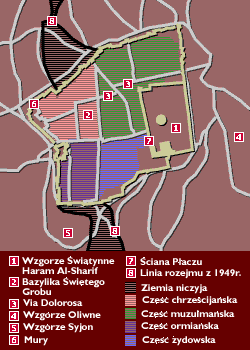 |
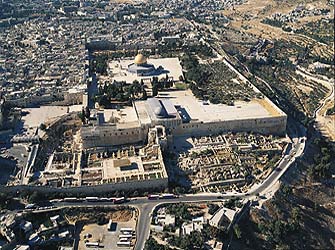 |
|
Wzgórze Świątynne - stara część Jerozolimy Do dziś zachowały się tylko szczątki murów Świątyni Jerozolimskiej (tzw. Ściana Płaczu) |
||
Współcześnie na jej miejscu stoi meczet Omara (Kubbet-es-Sachra lub Haram AL-Sharif, inaczej Świątynia Pańska, Kopuła na Skale) z VII w. po Chrystusie, a w południowej części terenu świątynnego – meczet al-Agsa z VIII w. po Chrystucie. |
||
|
|
||
| 36. Bordeaux Henry: La visage de Jérusalem et le Sphinx sans visage. Paris 1948 Les Deux Sirenes 16° ss. 302. 37. Leconte René: Jérusalem et les Lieux Saints. Paris 1954 Hachette 8° ss. 127, fot. Les Albums des Guides Bleus. 38. Jerusalem the saga of the Holy City. With contributions by Michael Avi-Yonah and an introduction by Benjamin Mazar (Maisler). Jerusalem 1954 The Universitas-Publ. 4° podł. s. VI, 76, tabl. 23. 39. Parrot André: Le temple de Jérusalem. Neuchatel [1955] Delachaux & Niestlé 8° ss. 94, [1], tabl. 6, il. Cahiers d'Archéologie Biblique. N. 5. 40. Sepher Yerushalayim. (The book of Jerusalem). Jerusalem, its natural conditions, history and development from the origins to the present day in 2 vol. Ed. by Michael Avi-Yonah. Ed. board L. A. Mayer, the late I. Press, S. Yeivin. Vol. 1. Jerusalem 1956 The Bialik Institute and Dvir Publishing House 4° ss. 18, 431, tabl. 70, map 40. 41. Jeremias Joachim: Jerusalem zur Zeit Jesu. Kulturgeschichtliche Untersuchung zur neutestamentlichen Zeitgeschichte. 2. Aufl. Göttingen 1958 Vandenhoeck & Ruprecht 8° ss. 262, [1]. 42. Bartke Hans: Vom Roten Meer zum See Genezareth. Bilder zur Landes- und Altertumskunde Palästinasnach eingen Aufnahmen des Verfassers während einer Studienreise im Sommer 1961. Berlin 1962 Union Verlag 8° ss. 102, mapa 1, il. 43. Histoire Jerusalem d'Abraham a nos jours. Dir. gén. Robert Laffont. Paris 1965 Pont Royal 4° ss.294, [2], il. Panoramas d'Histoire. 44. Kollek Théodore, Pearlman Moshe: Jérusalem. Ville sacrée de l'humanité. Quarante siecles d'histoire. Jerusalem 1968 Steimatzky 4° ss. 288, il. 45. Gray John: A history of Jerusalem. Illustred and with maps and plans. New York 1969 Frederick A. Praeger 8° ss. 336, tabl. [16], plany. |
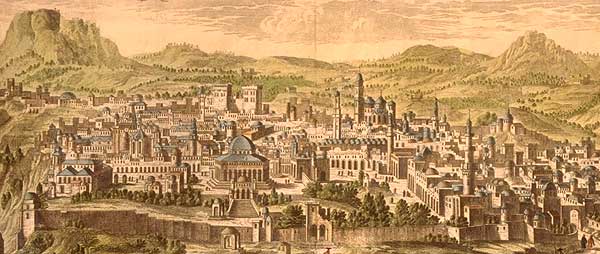 |
Panorama Jerozolimy - sztych z dzieła francuskiego autora: Pierre R. Aveline (1654-1722) IERUSALEM Comme elle est a présent, Paryż, ok. 1700; kolorowany ręcznie, 34,1 x 51,7 cm (Kyram Collection) |
| 46. Jerusalem 70. Jerusalem 1969 Franciscan Print. Press 8° s. 74, il. Cuasdernos de "Tierra Santa". 47. Jérusalem 70-1970. Jérusalem 1970 Franciscan Print. Press 8° ss. 65, il. Cahiers de "La Terre Sainte". 48. Storme Albert: Gethsemane. Transl. by Gerard Bushell. Jerusalem 1970 Franciscan Print. Press 16° ss. 109, il. The Holy Places of Palestine. 49. Storme Albert: Gethsemani. (bers. u. überarb. von Ambrosius Eickler. Jerusalem 1970 Franc. Print. Press 16° ss. 102, il. Heilige Statten Pal(stinas. 50. Ambelain Robert: Les lourds secrets du Golgotha. Paris 1974 Robert Laffont 8° ss. 413, [1], tabl. 4. Les Engmes de l'Univers. 51. Goichon Amelie Marie: Jérusalem. Fin de la ville universelle? Paris 1976 G.-P. Maisonneuve & Larose 16° ss. [9], 378, tabl. 21, mapa 1. 52. Wilkinson John: A Jérusalem avec Jésus. Trad. fr. de Jean Prignaud. Paris 1981 Cerf 8° ss. 250, il. 53. Peters Francis E.: Jerusalem. The holy city in the eyes chronicles, visitors, pilgrims and prophets from the days of Abraham to the beginnings of modern times. Princeton 1985 Princeton University Press 8° ss. XIV, 685, tabl. 42. 54. Sawicki Tom: The Jerusalem Handbook. Introduction by Teddy Kollek. Jerusalem 1987 The Jerusalem Institute for Israel Studies 4° ss. 80, il. |
| Według Koranu, Mahomet wstąpił do raju z wielkiej skały w centrum Wzgórza Świątynnego w Jerozolimie. Aby upamiętnić i ochronić to miejsce, w 691 roku kalif Damaszku wybudował słynną kopułę. Na zewnątrz była wyłożona złotymi mozaikami, które później Turcy otomańscy zamienili na 45 tysięcy perskich płytek ceramicznych. Dziś kopuła o średnicy 61 metrów pokryta jest pozłacaną aluminiową blachą, dekorowaną wersami z Koranu. Według tradycji żydowskiej skała pod kopułą to górą Moria, na której Abraham przygotowywał się do złożenia Bogu ofiary ze swego syna Izaaka i gdzie tysiąc lat przed nadejściem Chrystusa król Salomon wybudował pierwszą świątynię. W tym też miejscu miało nastąpić oczyszczenie Marii. Fundamentaliści trzech religii widzą to miejsce jako scenę dla wielkich wydarzeń przyszłości. Według Żydów i chrześcijan tutaj rozegra się ostateczna walka przed drugim nadejściem Mesjasza; według muzułmanów tutaj Jezus i Mahdi (Mesjasz) wspólnie zniszczą szatana i nawrócą na islam 'niewiernych'. |
||||
 |
| Opracowanie i redakcja: Jan Krzysztof Wasilewski |
Ostatnia aktualizacja: 20.07.2008, godz. 03:20 - Jan Wasilewski



